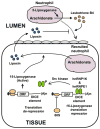Translation control: a multifaceted regulator of inflammatory response
- PMID: 20304832
- PMCID: PMC2860598
- DOI: 10.4049/jimmunol.0903778
Translation control: a multifaceted regulator of inflammatory response
Abstract
A robust innate immune response is essential to the protection of all vertebrates from infection, but it often comes with the price tag of acute inflammation. If unchecked, a runaway inflammatory response can cause significant tissue damage, resulting in myriad disorders, such as dermatitis, toxic shock, cardiovascular disease, acute pelvic and arthritic inflammatory diseases, and various infections. To prevent such pathologies, cells have evolved mechanisms to rapidly and specifically shut off these beneficial inflammatory activities before they become detrimental. Our review of recent literature, including our own work, reveals that the most dominant and common mechanism is translational silencing, in which specific regulatory proteins or complexes are recruited to cis-acting RNA structures in the untranslated regions of single or multiple mRNAs that code for the inflammatory protein(s). Enhancement of the silencing function may constitute a novel pharmacological approach to prevent immunity-related inflammation.
Conflict of interest statement
The authors have no financial conflicts of interest.
Figures




Similar articles
-
Post-transcriptional regulons coordinate the initiation and resolution of inflammation.Nat Rev Immunol. 2010 Jan;10(1):24-35. doi: 10.1038/nri2685. Nat Rev Immunol. 2010. PMID: 20029446 Review.
-
Translation control of TAK1 mRNA by hnRNP K modulates LPS-induced macrophage activation.RNA. 2014 Jun;20(6):899-911. doi: 10.1261/rna.042788.113. Epub 2014 Apr 21. RNA. 2014. PMID: 24751651 Free PMC article.
-
Post-transcriptional regulation of gene expression in innate immunity.Nat Rev Immunol. 2014 Jun;14(6):361-76. doi: 10.1038/nri3682. Nat Rev Immunol. 2014. PMID: 24854588 Review.
-
Targeting translational control as a novel way to treat inflammatory disease: the emerging role of microRNAs.Clin Exp Allergy. 2013 Sep;43(9):981-99. doi: 10.1111/cea.12170. Clin Exp Allergy. 2013. PMID: 23957346 Review.
-
Interleukin-17 (IL-17) and IL-1 activate translation of overlapping sets of mRNAs, including that of the negative regulator of inflammation, MCPIP1.J Biol Chem. 2013 Jun 28;288(26):19250-9. doi: 10.1074/jbc.M113.452649. Epub 2013 May 8. J Biol Chem. 2013. PMID: 23658019 Free PMC article.
Cited by
-
RIOK3 and Its Alternatively Spliced Isoform Have Disparate Roles in the Innate Immune Response to Rift Valley Fever Virus (MP12) Infection.Viruses. 2022 Sep 17;14(9):2064. doi: 10.3390/v14092064. Viruses. 2022. PMID: 36146870 Free PMC article.
-
The eIF4EBP-eIF4E axis regulates CD4+ T cell differentiation through modulation of T cell activation and metabolism.iScience. 2023 Apr 18;26(5):106683. doi: 10.1016/j.isci.2023.106683. eCollection 2023 May 19. iScience. 2023. PMID: 37187701 Free PMC article.
-
Resolution of Inflammation: What Controls Its Onset?Front Immunol. 2016 Apr 26;7:160. doi: 10.3389/fimmu.2016.00160. eCollection 2016. Front Immunol. 2016. PMID: 27199985 Free PMC article. Review.
-
N-Adamantyl Phthalimidine: A New Thalidomide-like Drug That Lacks Cereblon Binding and Mitigates Neuronal and Synaptic Loss, Neuroinflammation, and Behavioral Deficits in Traumatic Brain Injury and LPS Challenge.ACS Pharmacol Transl Sci. 2021 Mar 30;4(2):980-1000. doi: 10.1021/acsptsci.1c00042. eCollection 2021 Apr 9. ACS Pharmacol Transl Sci. 2021. PMID: 33860215 Free PMC article.
-
Brd4 modulates the innate immune response through Mnk2-eIF4E pathway-dependent translational control of IκBα.Proc Natl Acad Sci U S A. 2017 May 16;114(20):E3993-E4001. doi: 10.1073/pnas.1700109114. Epub 2017 May 1. Proc Natl Acad Sci U S A. 2017. PMID: 28461486 Free PMC article.
References
-
- Mazumder B, Seshadri V, Fox PL. Translational control by the 3′-UTR: the ends specify the means. Trends Biochem Sci. 2003;28:91–98. - PubMed
-
- Nathan C. Points of control in inflammation. Nature. 2002;420:846–852. - PubMed
-
- Kumar V, Abbas AK, Fausto N. Robbins and Cotran’s Pathologic Basis of Disease. 7. Saunders; Philadelphia: 2004.
-
- Mantovani A, Allavena P, Sica A, Balkwill F. Cancer-related inflammation. Nature. 2008;454:436–444. - PubMed
Publication types
MeSH terms
Grants and funding
LinkOut - more resources
Full Text Sources

